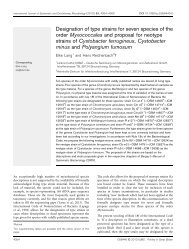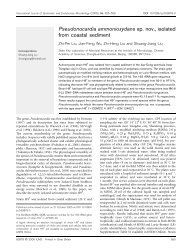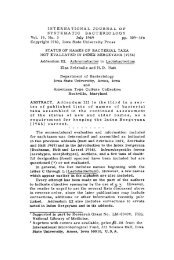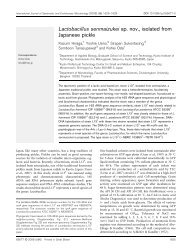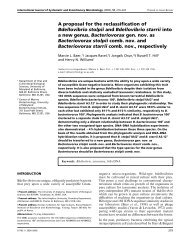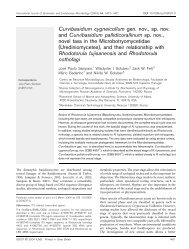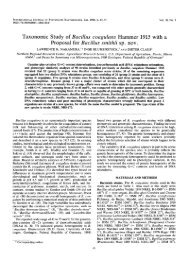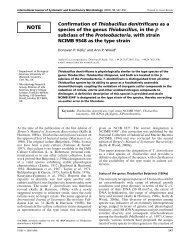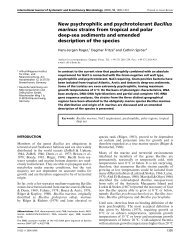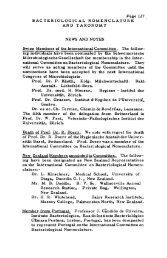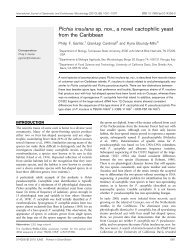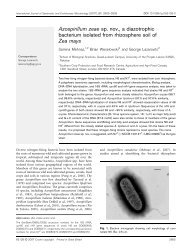Corynebacterium simulans sp. nov., a non - International Journal of ...
Corynebacterium simulans sp. nov., a non - International Journal of ...
Corynebacterium simulans sp. nov., a non - International Journal of ...
Create successful ePaper yourself
Turn your PDF publications into a flip-book with our unique Google optimized e-Paper software.
P. Wattiau, M. Janssens and G. Wauters<br />
according to criteria established for staphylococci by the<br />
National Committee for Clinical Laboratory Standards<br />
(1997).<br />
Chemotaxonomic studies. Cellular fatty acid composition<br />
was determined by GLC using a Delsi DI 200 chromatograph<br />
(Intersmat) as described elsewhere (Wauters et al.,<br />
1996). Mycolic acids were detected by TLC (Minnikin et al.,<br />
1980). Peptidoglycan analysis was performed by N. Weiss at<br />
DSMZ (Deutsche Sammlung von Mikroorganismen und<br />
Zellkulturen, Braunschweig, Germany), using a TLC<br />
method (Schleifer & Kandler, 1972). Cell wall sugars were<br />
determined as alditol acetates by GC (Saddler et al., 1991) by<br />
P. Schumann at the DSMZ.<br />
DNA preparation, restriction and sequencing. Total DNA<br />
from strains Co 301, Co 553T and Co 557 was prepared<br />
according to the method <strong>of</strong> Marmur (1961) except that cells<br />
were disrupted by sonification rather than by lysozyme<br />
treatment. A 15 kb PCR fragment corre<strong>sp</strong>onding to the 16S<br />
rDNA was generated with the Dynazyme thermostable<br />
polymerase (Finnzymes) using the 16S rDNA PCR primers<br />
‘27F’ and ‘1522R’ (Johnson, 1994) according to the<br />
following PCR protocol: 95 C for 30 s, 55 C for 30 s and<br />
72 C for 60 s (30 cycles). Sequencing reactions were obtained<br />
directly on ethanol-precipitated PCR products with<br />
the Thermosequenase kit (Amersham) using P-labelled<br />
oligonucleotides as sequencing primers. The universal forward<br />
and reverse 16S rDNA sequencing primers 321, 530,<br />
685, 1100, 1242 and 1392, numbered relative to the<br />
Escherichia coli 16S rRNA numbering, were used in this<br />
study (Johnson, 1994). The sequencing reactions were<br />
analysed by electrophoresis on 6% (wv) acrylamide, 8 M<br />
urea sequencing gels on a Macrophor unit (Pharmacia).<br />
Restriction analysis was assayed by incubating approximately<br />
01 µg ethanol-precipitated, PCR-amplified DNA<br />
with the relevant restriction enzyme in a buffer supplied by<br />
the manufacturer (Pharmacia). The restricted DNA was<br />
separated on a 15% (wv) agarose gel by electrophoresis at<br />
constant voltage in TBE buffer (Tris 05 M, boric acid 05 M<br />
and EDTA 10 mM, pH 83) together with a molecular<br />
weight standard (Life Technologies) and stained with<br />
ethidium bromide.<br />
Nucleotide sequence comparison and phylogenetic analysis.<br />
The FASTA s<strong>of</strong>tware was used for DNA homology<br />
searches (Pearson & Lipman, 1988). When available, prealigned<br />
16S rDNA sequences from other <strong>Corynebacterium</strong><br />
<strong>sp</strong>ecies were retrieved from the small ribosomal subunit<br />
(SSU) RNA database (Van de Peer et al., 1998) and aligned<br />
with the newly determined sequences. 16S rDNA sequences<br />
not found in the SSU RNA database were retrieved from the<br />
EMBL and Genbank databases and aligned manually with<br />
the pre-aligned sequences. Multiple sequence alignments<br />
were generated manually and approximately 100 bases at the<br />
5 end <strong>of</strong> the molecule were removed to avoid alignment<br />
uncertainties due to hypervariable domain V1. The multiple<br />
alignment encompassed nucleotides 122–1361 relative to the<br />
E. coli 16S rRNA numbering. Phylogenetic tree data were<br />
calculated using the PAUPSEARCH s<strong>of</strong>tware (Sw<strong>of</strong>ford, 1990)<br />
run on a SUN Enterprise 450 workstation. The neighbourjoining,<br />
maximum-likelihood and parsimony methods <strong>of</strong><br />
tree construction were applied on the aligned sequences. The<br />
Kimura two-parameter distance correction method was used<br />
for calculating the neighbour-joining tree. Branches that<br />
were found by all the three methods were considered relevant<br />
and validated by a bootstrap analysis (1500 replications)<br />
using PAUPSEARCH. The RETREE and DRAWGRAM programs<br />
from the PHYLIP s<strong>of</strong>tware package version 3.5 (Felsenstein,<br />
1989) were used to manipulate and draw the phylogenetic<br />
trees generated by PAUPSEARCH.<br />
RESULTS AND DISCUSSION<br />
Strains Co 301, Co 553T and Co 557 were isolated from<br />
a foot abscess, a biopsy <strong>of</strong> an axillar lymph node and<br />
a boil, re<strong>sp</strong>ectively. Although the first isolate grew in<br />
pure culture from deep-sited pus, disease association<br />
was not proved and a possible pathogenic role <strong>of</strong> such<br />
strains remains to be established.<br />
On Columbia blood agar, colonies were about 05–<br />
10 mm in diameter after 24 h <strong>of</strong> incubation in air at<br />
37 C and 1–2 mm after 48 h. They were greyish-white,<br />
opaque and glistening, similar to colonies <strong>of</strong> C.<br />
striatum and C. minutissimum. The strains were not<br />
lipophilic. Growth was facultatively anaerobic but was<br />
enhanced in air. Gram stain showed Gram-positive<br />
rods with a typical diphtheroid arrangement.<br />
Biochemical characterization by conventional methods<br />
yielded a pr<strong>of</strong>ile close to that <strong>of</strong> C. striatum (Wauters<br />
et al., 1998; Funke et al., 1997a). The strains were<br />
catalase-positive, <strong>non</strong>-motile and fermentative. Nitrate<br />
reduction was positive, urease was negative.<br />
Pyrazinamidase was positive in two strains and negative<br />
in one. Glucose and sucrose were fermented but<br />
not maltose and mannitol. Tyrosinase and Tween<br />
esterase were positive. The CAMP (Christie–Atkins–<br />
Munch–Petersen) reaction was negative. The three<br />
strains di<strong>sp</strong>layed strong nitrite reduction in nitrite<br />
broths with both low and high concentrations. Nitritereducing<br />
strains have been described in organisms<br />
resembling C. striatum (Markowitz & Coudron, 1990).<br />
In our experience, most strains <strong>of</strong> C. striatum reduce<br />
nitrite at the lower concentration <strong>of</strong> 0001% but not at<br />
001%. A few strains (including the type strain) do not<br />
reduce nitrite at either concentration and a few others<br />
are strong reducers even at 001% (unpublished data).<br />
The numerical code obtained with the API CORYNE<br />
system (V2-0) was 2100305 for strain Co 553T. According<br />
to the manufacturer, this code corre<strong>sp</strong>onds to<br />
<strong>Corynebacterium</strong> ‘CDC group G’ and C. striatum<br />
<strong>Corynebacterium</strong> amycolatum with a confidence level<br />
<strong>of</strong> 870% and 107%, re<strong>sp</strong>ectively. For strain Co 557,<br />
the code was 0100305 which corre<strong>sp</strong>onds to <strong>Corynebacterium</strong><br />
macginleyi, ‘CDC group G’ and C.<br />
striatumC. amycolatum with confidence levels <strong>of</strong><br />
844%, 11% and 27%, re<strong>sp</strong>ectively. For strain Co<br />
301, the code was 2100105 corre<strong>sp</strong>onding to C.<br />
striatumC. amycolatum with a confidence level <strong>of</strong><br />
887%. However, upon addition <strong>of</strong> zinc dust after<br />
reagents for nitrate reduction, as recommended for the<br />
API 20NE strips, it appeared that the nitrate reduction<br />
was falsely negative because <strong>of</strong> the strong nitrite<br />
reduction. After correction <strong>of</strong> the nitrate result, the<br />
numerical codes <strong>of</strong> the three strains became 3100305<br />
(<strong>Corynebacterium</strong> ‘CDC group G’ 550%, C. striatumC.<br />
amycolatum 430%), 1100305 (C. macginleyi<br />
994%) and 3100105 (C. striatumC. amycolatum<br />
985%), re<strong>sp</strong>ectively.<br />
348 <strong>International</strong> <strong>Journal</strong> <strong>of</strong> Systematic and Evolutionary Microbiology 50



